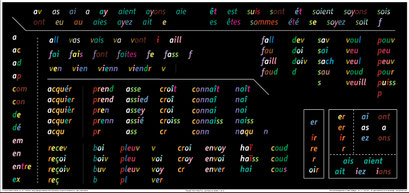French Silent Way Plus (for non-beginners)
The Rectangle chart
The revised Rectangle chart was designed specifically for learners of French as a foreign language. The layout reflects the tongue position and the positions of other articulators used in production.
(Click the pictures to enlarge them.)
As can be seen in the pictures above and below, the Rectangle chart and the Silent Way Plus Fidel (Spelling chart) are laid out with the same placement of sounds (red /i/ in the top left, for example).
The Silent Way Plus Fidel
The SW+ Fidel is a chart which enables both the spelling and the pronunciation of any word in French to be pointed at the same time. The regularities underlying the writing system are on display. When the teacher introduces new words, correct spelling and correct pronunciation are always associated.
When French speakers write, they maintain two dialogues within themselves. They think about the content of what they write, but they must also constantly think about the grammatical agreement of the words while writing. Those agreements that can be heard—nous with -ons, for example—are not a problem. It is those that are not audible that require constant vigilance. This Fidel helps students to create this second internal dialogue.
Below the consonants, on the left, there are the <s> and <x> of the plurals of the determiners, nouns and adjectives. On the right, there are the inaudible endings <e>, <es> and <ent>, which are used for all the verbs of the first group in the present indicative, and some other verbs, as well as the present subjunctive. There are also <s> and <t> for the other groups and <x> for pouvoir and vouloir. The SW+ Fidel is designed for students to point phrases and short sentences to develop the inner dialogue that agreement requires.
Thus the SW+ Fidel differs from the SW Fidel for which one touch of the pointer always triggers one sound.
It comes with a key giving examples of all the sound-spelling combinations of French.
The Silent Way Plus Word charts
Non-beginners in French typically make most mistakes in the pronunciation and grammar of the language. The SW+ Word charts were designed to help teachers work effectively on these problems.
These charts display the functional vocabulary of French. Notice that combining forms are marked with a tilde (e.g. mienne is constructed on chart 3 as 'm~' + '~ienne').
The words on these charts are loosely grouped by the grammatical function they most often play. The groups are delineated by coloured angles.
The Silent Way Plus Conjugation chart
Completing the SW+ set, the Conjugation chart shows all the forms that French verbs can take. This synthesis of stems and endings helps students, both non-French and French-speaking, to develop a sense of how conjugation functions in the language.
When students come across a new verb, they can be asked to look for which of the verbs on the chart is likely to be the model for its conjugation. The students are able to explore the system and discover its regularities and exceptions. As with the Fidel, the fact that the complete task is visible sets a reassuring boundary: "all this; but no more."
For more information on the layout of this chart and its use, click here.
For sizes, pricing and other information, return to the Silent Way for French page.
 Pronunciation Science
Pronunciation Science








